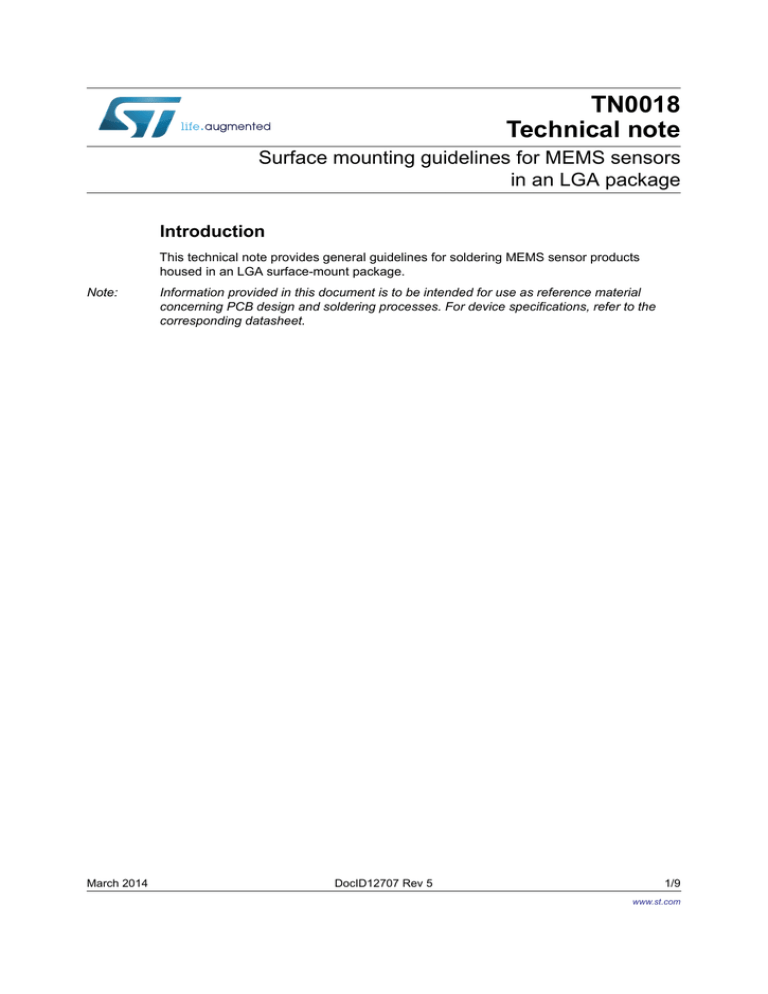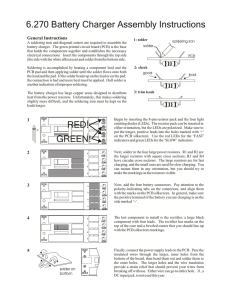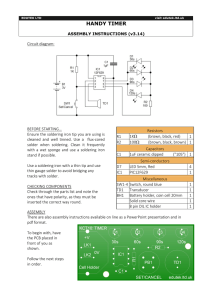
TN0018
Technical note
Surface mounting guidelines for MEMS sensors
in an LGA package
Introduction
This technical note provides general guidelines for soldering MEMS sensor products
housed in an LGA surface-mount package.
Note:
March 2014
Information provided in this document is to be intended for use as reference material
concerning PCB design and soldering processes. For device specifications, refer to the
corresponding datasheet.
DocID12707 Rev 5
1/9
www.st.com
Contents
TN0018
Contents
1
General guidelines for soldering surface-mount MEMS sensors . . . . . 3
2
PCB design guidelines . . . . . . . . . . . . . . . . . . . . . . . . . . . . . . . . . . . . . . . 4
2.1
PCB design rules . . . . . . . . . . . . . . . . . . . . . . . . . . . . . . . . . . . . . . . . . . . . 5
3
Stencil design and solder paste application . . . . . . . . . . . . . . . . . . . . . 6
4
Process considerations . . . . . . . . . . . . . . . . . . . . . . . . . . . . . . . . . . . . . . 6
5
Solder heat resistance and environmental specifications . . . . . . . . . . 7
6
Revision history . . . . . . . . . . . . . . . . . . . . . . . . . . . . . . . . . . . . . . . . . . . . 8
2/9
DocID12707 Rev 5
TN0018
1
General guidelines for soldering surface-mount MEMS sensors
General guidelines for soldering surface-mount
MEMS sensors
The following three elements must be considered in order to adhere to common PCB design
and good industrial practices when soldering MEMS sensors:
PCB design should be as symmetrical as possible
–
large traces on Vdd / Gnd lines are not required (very low power consumption)
–
no vias or traces below the sensor footprint
Solder paste must be as thick as possible (after soldering) in order to:
–
reduce the decoupling stress from the PCB to the sensor
–
avoid that the PCB solder mask touches the device package
Solder paste thickness must be as uniform as possible (after soldering) to avoid
uneven stress:
–
Final volume of soldering paste within 20% among lands is possible using the SPI
(Solder Paste Inspection) control technique
DocID12707 Rev 5
3/9
9
PCB design guidelines
2
TN0018
PCB design guidelines
PCB land and solder mask general recommendations are shown in Figure 1. Refer to the
device datasheet for pad count, size and pitch.
It is recommended to open the solder mask external to the PCB land;
It is strongly recommended not to place any structure on the top metal layer
underneath the sensor (on the same side of the board). This must be defined as a
keepout area.
Traces connected to pads should be as much symmetric as possible. Symmetry and
balance for pad connection will help component self-alignment and will lead to better
control of solder paste reduction after reflow;
For optimal performance of the device, it is strongly recommended to place screw
mounting holes at a distance greater than 2 mm from the sensor.
If present, the pin #1 indicator must be left unconnected to ensure proper device
functionality.
In order to prevent noise coupling and thermo-mechanical stress, following standard
industry design practices for component placement is advised.
4/9
DocID12707 Rev 5
TN0018
2.1
PCB design guidelines
PCB design rules
Figure 1. Recommended land and solder mask design for LGA packages
Package
footprint
Solder mask opening
external to land footprint:
recommended to
increase device to PCB
clearance
C
D
PCB land
A
B
PCB land design and connecting traces should be designed symmetrically.
For LGA pin spacing greater than 200 μm:
A = PCB land length = LGA solder pin length + 0.1 mm
B = PCB land width = LGA solder pin width + 0.1 mm
For LGA pin spacing equal to or less than 200 μm:
A = PCB land length = LGA solder pin length
B = PCB land width = LGA solder pin width
C = Solder mask opening length (when applicable) = PCB land length + 0.1 mm
D = Solder mask opening width = PCB land width + 0.1 mm
DocID12707 Rev 5
5/9
9
Stencil design and solder paste application
3
TN0018
Stencil design and solder paste application
The thickness and the pattern of the soldering paste are important for the proper MEMS
sensor mounting process.
Stainless steel stencils are recommended for solder paste application;
A stencil thickness of 90 - 150 μm (3.5 - 6 mils) is recommended for screen printing;
The openings of the stencil for the signal pads should be between 70% and 90% of the
PCB pad area;
Optionally, for better solder paste release, the aperture walls should be trapezoidal and
the corners rounded;
The fine pitch of the IC leads requires accurate alignment of the stencil to the printed
circuit board. The stencil and printed circuit assembly should be aligned to within 25 μm
(1 mil) prior to application of the solder paste.
4
Process considerations
6/9
The soldering profile depends on the number, size and placement of components in the
application board. For this reason it is not possible to define a unique soldering profile
for the sensor only. The customer should use a time and temperature reflow profile
based on PCB design and manufacturing expertise.
In order to reduce residual stress on the components, the recommended ramp-down
temperature slope should not exceed -3 °C/s.
No solder material reflow on the side of the package is allowed since LGA packages
show metal traces on the side of the package.
If “self-cleaning” solder paste is not used, the board must be properly cleaned after
soldering to eliminate any possible source of leakage between adjacent pads due to
flux residues.
The final volume of soldering paste applied to each PCB land is recommended to be
within 20% among (all) the PCB land pads.
Based on the Jedec 9702 standard, a component shows negligible output variation up
to stress intensity of 500 me (microstrain).
DocID12707 Rev 5
TN0018
5
Solder heat resistance and environmental specifications
Solder heat resistance and environmental
specifications
In order to meet environmental requirements, ST offers these devices in ECOPACK®
packages. These packages have a lead-free second level interconnect. The category of
second level interconnect is marked on the inner box label, in compliance with JEDEC
Standard JESD97. The maximum ratings related to soldering conditions are also marked on
the inner box label.
LGA packages for MEMS sensors are qualified for soldering heat resistance according to
JEDEC J-STD-020, in MSL3 condition.
DocID12707 Rev 5
7/9
9
Revision history
6
TN0018
Revision history
Table 1. Document revision history
8/9
Date
Revision
Changes
12-Oct-2006
1
Initial release
30-Apr-2008
2
Added appendix with mechanical information
30-Jul-2013
3
Updated Section 2: PCB design guidelines
Updated Section 4: Process considerations
Removed Appendix A with LGA package drawings and dimensions
Minor textual updates throughout technical note
31-Oct-2013
4
Textual update in Note on page 5
24-Mar-2014
5
Updated Section 2: PCB design guidelines; Section 3: Stencil design
and solder paste application; and Section 4: Process considerations
DocID12707 Rev 5
TN0018
Please Read Carefully:
Information in this document is provided solely in connection with ST products. STMicroelectronics NV and its subsidiaries (“ST”) reserve the
right to make changes, corrections, modifications or improvements, to this document, and the products and services described herein at any
time, without notice.
All ST products are sold pursuant to ST’s terms and conditions of sale.
Purchasers are solely responsible for the choice, selection and use of the ST products and services described herein, and ST assumes no
liability whatsoever relating to the choice, selection or use of the ST products and services described herein.
No license, express or implied, by estoppel or otherwise, to any intellectual property rights is granted under this document. If any part of this
document refers to any third party products or services it shall not be deemed a license grant by ST for the use of such third party products
or services, or any intellectual property contained therein or considered as a warranty covering the use in any manner whatsoever of such
third party products or services or any intellectual property contained therein.
UNLESS OTHERWISE SET FORTH IN ST’S TERMS AND CONDITIONS OF SALE ST DISCLAIMS ANY EXPRESS OR IMPLIED
WARRANTY WITH RESPECT TO THE USE AND/OR SALE OF ST PRODUCTS INCLUDING WITHOUT LIMITATION IMPLIED
WARRANTIES OF MERCHANTABILITY, FITNESS FOR A PARTICULAR PURPOSE (AND THEIR EQUIVALENTS UNDER THE LAWS
OF ANY JURISDICTION), OR INFRINGEMENT OF ANY PATENT, COPYRIGHT OR OTHER INTELLECTUAL PROPERTY RIGHT.
ST PRODUCTS ARE NOT DESIGNED OR AUTHORIZED FOR USE IN: (A) SAFETY CRITICAL APPLICATIONS SUCH AS LIFE
SUPPORTING, ACTIVE IMPLANTED DEVICES OR SYSTEMS WITH PRODUCT FUNCTIONAL SAFETY REQUIREMENTS; (B)
AERONAUTIC APPLICATIONS; (C) AUTOMOTIVE APPLICATIONS OR ENVIRONMENTS, AND/OR (D) AEROSPACE APPLICATIONS
OR ENVIRONMENTS. WHERE ST PRODUCTS ARE NOT DESIGNED FOR SUCH USE, THE PURCHASER SHALL USE PRODUCTS AT
PURCHASER’S SOLE RISK, EVEN IF ST HAS BEEN INFORMED IN WRITING OF SUCH USAGE, UNLESS A PRODUCT IS
EXPRESSLY DESIGNATED BY ST AS BEING INTENDED FOR “AUTOMOTIVE, AUTOMOTIVE SAFETY OR MEDICAL” INDUSTRY
DOMAINS ACCORDING TO ST PRODUCT DESIGN SPECIFICATIONS. PRODUCTS FORMALLY ESCC, QML OR JAN QUALIFIED ARE
DEEMED SUITABLE FOR USE IN AEROSPACE BY THE CORRESPONDING GOVERNMENTAL AGENCY.
Resale of ST products with provisions different from the statements and/or technical features set forth in this document shall immediately void
any warranty granted by ST for the ST product or service described herein and shall not create or extend in any manner whatsoever, any
liability of ST.
ST and the ST logo are trademarks or registered trademarks of ST in various countries.
Information in this document supersedes and replaces all information previously supplied.
The ST logo is a registered trademark of STMicroelectronics. All other names are the property of their respective owners.
© 2014 STMicroelectronics - All rights reserved
STMicroelectronics group of companies
Australia - Belgium - Brazil - Canada - China - Czech Republic - Finland - France - Germany - Hong Kong - India - Israel - Italy - Japan Malaysia - Malta - Morocco - Philippines - Singapore - Spain - Sweden - Switzerland - United Kingdom - United States of America
www.st.com
DocID12707 Rev 5
9/9
9


